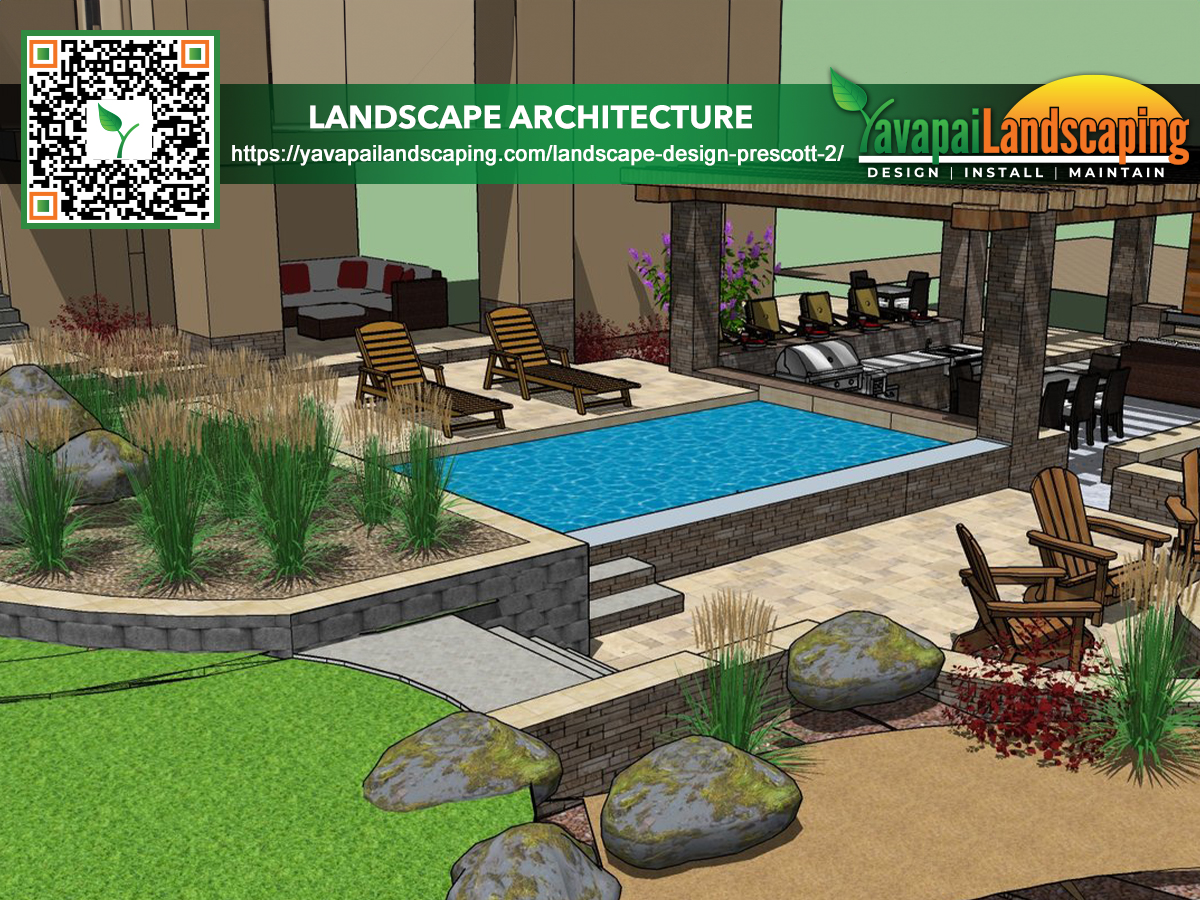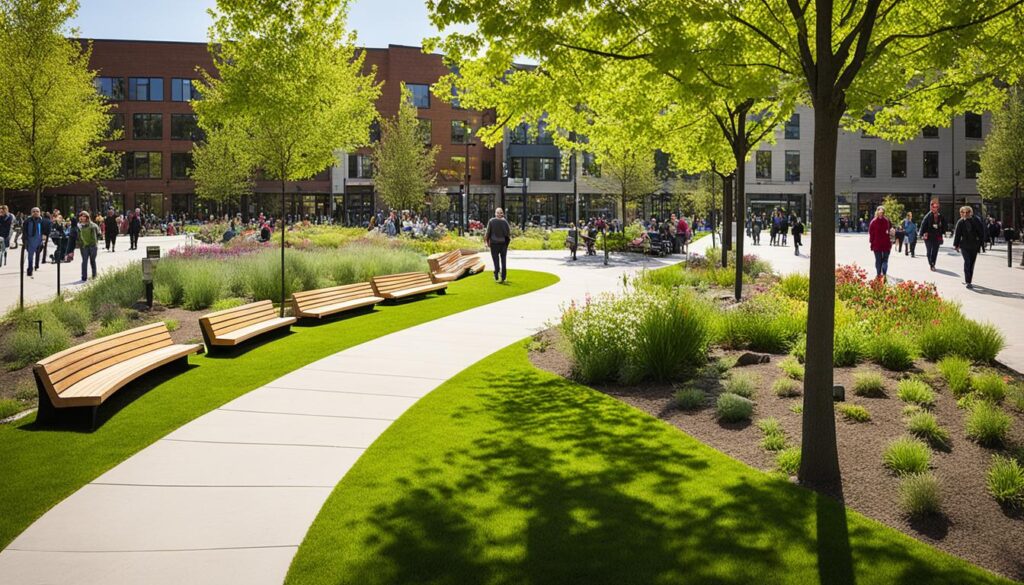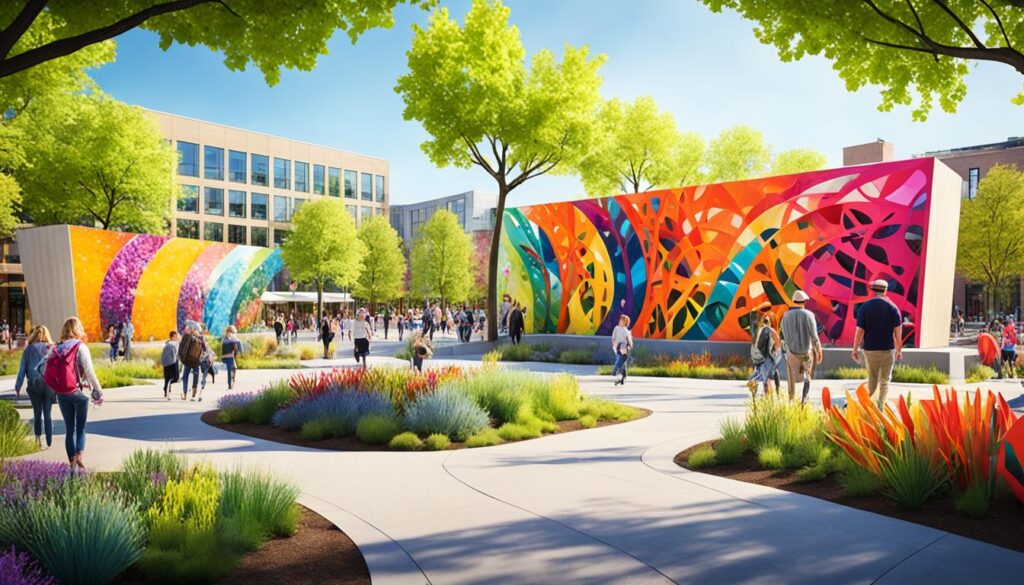
Urban parks are very important for our cities. They make our cities better and more green. Landscape architects are key in making these parks. They use many elements to design fun and useful outdoor places. This article talks about the main parts of making a great city park. It shows how smart design can change empty areas into lively places for fun, calm, and culture.
Key Takeaways
- Urban parks are essential for creating livable and sustainable cities.
- Landscape architects play a vital role in designing engaging and functional community spaces.
- Thoughtful green design can transform underutilized areas into vibrant recreational facilities.
- Incorporating public art and cultural elements can enhance the sense of place and community identity.
- Comprehensive management and community stewardship are crucial for the long-term success of urban parks.

What Are Key Elements in Urban Park Development in Landscape Architecture?
Urban parks make our cities better places to live. Urban parks are very important. They help our cities be better for everyone. This is why urban parks must be designed well, so all can use them.
Understanding the Importance of Urban Parks
Urban parks are not just grass and trees. They are places where communities come together. People meet and talk in these areas. They also help keep us healthy by encouraging us to move.
This is why urban park design focuses on what people need. By doing this, parks can be places everyone loves. They make life in the city better for us all.
Key Considerations in Urban Park Design
Making a park is more than just planting trees. Landscape architects think about who will use the park. They also think about how it fits in with the city around it.
Things like easy paths, fun things to do, and natural beauty are key. These ideas help make parks usable by everyone. They make the park a place where all can enjoy.
Enhancing Accessibility and Inclusivity
Making sure everyone can use urban parks is very important. Landscape architects build parks for all kinds of people. They want everyone to feel welcome and have fun at the park.
They add easy paths and fun things that everyone can enjoy. This makes parks a place where everyone feels they belong. It helps make our societies fair and equal.
Sustainable Landscape Practices for Urban Parks
Sustainability guides modern urban park design. Landscape architects enhance public spaces with eco-friendly practices. These practices make the areas beautiful and strong for communities.
Incorporating Native Vegetation
Using native plants is a big part of making parks greener. These plants are from the area and need less water. They also help local animals and make the park easier to care for.
Efficient Water Management Strategies
Managing water well is key in park design. Architect use smart water ways to, like saving rainwater and using plants that don’t need much water. These choices help the park use less clean water and are better for the environment.
Promoting Biodiversity and Ecological Balance
Architects also work to keep the parks full of life and balanced. They create homes for animals and use eco-friendly ways to manage the park. This makes the park nicer for both nature and people.
Creating Engaging and Multifunctional Spaces
Successful urban parks have many fun things to do. They are designed by landscape architects. These multifunctional urban park spaces include trails, playgrounds, sports areas, and quiet spots. They help everyone find something they enjoy. This makes urban parks feel like a community and helps people stay active.
Landscape architects make sure parks are great for many activities. They bring together different things so all kinds of people enjoy the parks. This includes families, those who love being active, and people who like nature.
| Multifunctional Features | Benefits for Community |
|---|---|
| Walking/Jogging Trails | Promote physical activity and enable fitness routines |
| Playgrounds and Recreational Areas | Provide entertainment and encourage active play for children and families |
| Sports Facilities | Facilitate organized sports, team activities, and community events |
| Quiet Contemplative Spaces | Offer opportunities for relaxation, reflection, and stress relief |
Urban parks blend all these activities. They offer something for everyone. This makes the parks welcoming and promotes health. It encourages people to be together and live an active life.

Integrating Public Art and Cultural Elements
Adding art and cultural things to city parks makes them special. It helps people feel like they belong. Artists, designers, and the community work together. They add things like sculptures and murals. These show the area’s past and diversity. They make the park more beautiful and bring people closer.
Celebrating Local History and Heritage
Public art in parks can tell a community’s story. Parks become lively places that share local culture. Architects and artists team up. They create art that speaks to the area’s unique tales. This makes the park a part of the community. And invites visitors to connect with its history.
Encouraging Community Engagement
Putting cultural elements in urban parks does more than look nice. It gets everyone involved. Architects lead projects that welcome community input. This includes residents’ ideas, stories, and art. This makes people proud and involved. The park then truly reflects the community’s values and dreams.
| Benefits of Integrating Public Art and Cultural Elements | Strategies for Successful Implementation |
|---|---|
| Enhances the sense of place and community identity Celebrates local history, heritage, and cultural diversity Promotes community engagement and pride Beautifies the park and creates visually appealing spaces | Collaborate with local artists and community stakeholders Design public art and installations that reflect the area’s unique narratives Facilitate participatory projects that invite community involvement Integrate cultural elements seamlessly into the park’s overall design Develop ongoing programming and events to sustain community engagement |
Planning for Maintenance and Long-Term Success
Keeping an urban park alive for a long time needs careful planning and work. People like landscape architects work closely with the city and groups in the area. They make plans for keeping the park looking nice, fixing things, and doing fun activities there.
Developing a Comprehensive Management Plan
A good plan for long-term park management is super important. It should say what needs to be taken care of, how to use the money for it, and who will help. Doing this helps keep the park loved and useful for the community for many years.
Fostering Community Stewardship
Getting the community involved is key for the park’s future. Landscape architects might start programs for people to help out or learn more about the park. This makes people feel like the park is theirs, and that love and care keep the park beautiful and fun. Discover the awesomeness of this article.
Trends and Innovations in Urban Park Design
Cities are always changing, and so are the parks within them. Now, landscape architects use new ideas to design these urban parks. One big new thing is using green technology, like solar lights and water-saving systems. These help the planet and show how much we care about it.
People love parks that make them feel and see new things. Now, parks are built to make you use all your senses. You’ll see amazing art, hear water flowing, and smell beautiful plants. This makes your park visit much more fun and interesting.
Modern parks are becoming smarter because of technology. They can check how many people visit and take care of themselves. Even your phone can help you find your way around the park! This makes parks safer, more fun, and better for everyone.
Landscape architects keep learning new ways to make parks better as cities grow. These new ideas will make sure parks stay fun, useful, and good for the planet. So, urban parks will always be a special part of our cities, where anyone can enjoy nature.
Yavapai Landscaping Prescott offers free quotes for Prescott and its surrounding areas for landscaping and tree services. This includes tree removal, trimming, stump grinding, land clearing, storm clean up, and emergency tree service.
